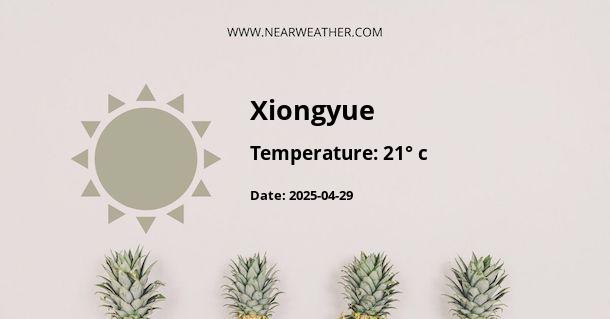Climate and Weather in Xiongyue, China
Xiongyue is a fascinating location in China known for its unique climate and weather patterns. Situated in the northeastern part of the country, Xiongyue experiences distinct seasons throughout the year. In this article, we will explore the climate and weather conditions in Xiongyue, providing detailed information about temperature, precipitation, and other key factors that contribute to the region's climate.
Geographical Location
Xiongyue is located in the Huludao City of Liaoning Province in China. It lies in the eastern part of the Liaoning Peninsula and is adjacent to the Bohai Sea in the south. Its geographical coordinates are approximately 40.53°N latitude and 120.73°E longitude. The city is surrounded by mountains and has a diverse topography, with elevations ranging from 100 to 500 meters above sea level.
Climate Classification
Xiongyue falls under the humid continental climate classification. This means that the region experiences hot summers and cold winters, with distinct seasonal variations in temperature and precipitation. The climate in Xiongyue is influenced by its proximity to the Bohai Sea and the Siberian High pressure system, which leads to a unique weather pattern.
Temperature
The average annual temperature in Xiongyue is around 8.5°C (47.3°F). Summers in Xiongyue are warm and humid, with average temperatures reaching around 24°C (75.2°F) in July, the hottest month. However, occasional heatwaves can push temperatures up to 30°C (86°F) or higher. Winters are cold and dry, with average temperatures dropping to around -10°C (14°F) in January, the coldest month. Extreme cold spells can cause temperatures to plummet even further, reaching below -20°C (-4°F).
Spring and autumn in Xiongyue are relatively short seasons, characterized by mild temperatures. Spring brings gradual warming, with temperatures ranging from 5°C (41°F) to 15°C (59°F). Autumn experiences a gradual cooling, with temperatures ranging from 10°C (50°F) to 20°C (68°F).
Precipitation
Xiongyue has a moderate amount of precipitation throughout the year, with an average annual rainfall of around 700-800 millimeters (27.5-31.5 inches). The majority of the precipitation occurs during the summer months, with July and August being the wettest months. The city also experiences a significant amount of snowfall during the winter season, with an average annual snowfall of about 50 centimeters (19.7 inches).
Due to its coastal location, Xiongyue is also prone to typhoons during the late summer and early autumn. These tropical cyclones can bring heavy rainfall and strong winds to the region.
Sunshine Hours
Xiongyue enjoys a moderate amount of sunshine throughout the year. The city experiences an average of 2,500-2,800 hours of sunshine annually. The sunniest months are typically July and August, with an average of 7-8 hours of sunshine per day. In contrast, winter months tend to have fewer sunshine hours, with an average of 3-4 hours per day.
Winds
Xiongyue experiences prevailing winds from the northwest during the winter months, which bring cold air from Siberia. These winds can be strong and contribute to the overall chilliness of the season. In summer, the prevailing winds shift to southeasterly directions, bringing warm and moist air from the Bohai Sea.
Conclusion
Xiongyue's climate exhibits distinct seasonal variations, with hot and humid summers and cold and dry winters. The city experiences a moderate amount of precipitation throughout the year, with the majority of rainfall occurring in the summer months. Xiongyue's location near the Bohai Sea and its varied topography contribute to its unique climate. Whether you visit Xiongyue in summer or winter, you can expect different weather conditions that add to the charm of this fascinating location.
A - Xiongyue's Latitude is 40.177368 & Longitude is 122.122841.
A - Weather in Xiongyue is 21° today.
A - Climate Conditions in Xiongyue shows clear sky today.
A - Humidity in Xiongyue is 37% today.
A - Wind speed in Xiongyue is 21.28 km/h, flowing at 207° wind direction. today.
